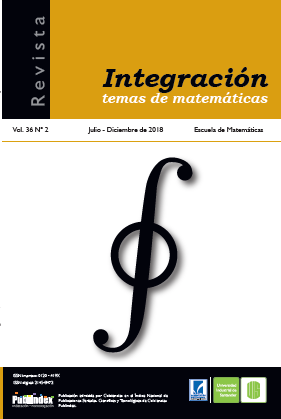Publicado 2018-12-11
Palabras clave
- Algoritmo genético continuo,
- calibración,
- identificación de parámetros,
- sedimentación
Cómo citar
Resumen
En este artículo se considera el problema de la determinación de la función de flujo en una ley de conservación escalar que modela el fenómeno de sedimentación. Los datos de la observación experimental utilizada para la calibración corresponden a un perfil de la concentración de sólidos en un tiempo fijo. El problema de identificación se formula como uno de optimización, donde la función objetivo es la de mínimos cuadrados que minimiza la distancia entre los perfiles solución del modelo y la observación. La solución del problema directo es aproximada por un esquema de volúmenes finitos monótono. La solución numérica del problema de calibración se obtiene mediante un algoritmo genético continuo. Se presentan resultados numéricos para validar la eficiencia del algoritmo propuesto.
Descargas
Referencias
[2] Bürger R., Coronel A. and Sepúlveda M., “A numerical descent method for an inverse problem of a scalar conservation law modelling sedimentation”, in Numerical Mathematics and Advanced Applications: Numerical Mathematics and Advanced Applications: Proceedings ENUMATH 2007, Springer Verlag, Providence, RI (2008), 225–232.
[3] Bürger R., Coronel A. and Sepúlveda M., “Numerical solution of an inverse problem for a scalar conservation law modelling sedimentation”, in Hyperbolic problems: theory, numerics and applications, volume 67 of Proc. Sympos. Appl. Math., Amer. Math. Soc., Providence, RI (2009), 445–454.
[4] Bürger R. andWendlandW. L., “Sedimentation and suspension flows: historical perspective and some recent developments”, J. Engrg. Math. 41 (2001), No. 2-3, 101–116.
[5] Bustos M. C., Concha F., Bürger R. and Tory E. M., Sedimentation and thickening, vol 8 of Mathematical Modelling: Theory and Applications, Kluwer Academic Publishers, Dordrecht, 1999.
[6] Concha F. and Bürger R., “Thickening in the 20th century: a historical perspective”, Minerals & Metallurgical Process 20 (2003), No. 2, 57–67.
[7] Engquist B. and Osher S., “One-sided difference approximations for nonlinear conservation laws”, Math. Comput. 36 (1981), 321–351.
[8] Eymard R., Gallouët T. and Herbin R., “Finite volume methods”, in Handbook of numerical analysis, Volume VII: Handb. Numer. Anal. North-Holland, Amsterdam, (2000), 713–1020.
[9] Fogel L.J., Owens A.J. and Walsh M.J., Artificial intelligence through simulated evolution, Wiley, Chichester, WS, UK, 1966.
[10] Gaffney J., Pearce C. and Green D., “Binary versus real coding for genetic algorithms: A false dichotomy?”, ANZIAM J. 51 (EMAC2009), C347–C359, 2010.
[11] Goldberg D.E., Genetic Algorithms in Search, Optimization and Machine Learning, Addison-Wesley Longman Publishing Co., Inc., Boston, MA, USA, 1st edition, 1989.
[12] Hansen N., Auger A., Ros R., Finck S. and Pošík P., “Comparing results of 31 algorithms from the black-box optimization benchmarking bbob-2009”, in Proceedings of the 12th Annual Conference Companion on Genetic and Evolutionary Computation, GECCO ’10, New York, NY, USA, (2010), 1689–1696.
[13] Haupt R.L. and Haupt S.E., Practical genetic algorithms, Wiley-Interscience [John Wiley & Sons], Hoboken, NJ, second edition, 2004.
[14] Holland J.H., Adaptation in Natural and Artificial Systems, University of Michigan Press, Ann Arbor, MI, USA, 1975.
[15] Koza J.R., Genetic Programming: On the Programming of Computers by Means of Natural Selection, MIT Press, Cambridge, MA, USA, 1992.
[16] Kynch G.J., “A theory of sedimentation”, Trans. Faraday Soc 48 (1952), 166–176.
[17] LeVeque R.J., Numerical methods for conservation laws, Lectures in Mathematics ETH Zürich, Second edition, Basel: Birkhäuser Verlag, 1992.
[18] Michalewicz Z., Genetic algorithms + data structures = evolution programs, Artificial Intelligence, Springer-Verlag, Berlin, 1996.
[19] Rechenberg I., Evolutionstrategie: Optimierung Technisher Systeme nach Prinzipien des Biologischen Evolution, Fromman-Hozlboog Verlag, Stuttgart, 1973.
[20] Sweeney M.W. and Kabouris J.C., “Modeling, Instrumentation, Automation, and Optimization of Water Resource Recovery Facilities”, Water Environment Research 88 (2016), 1279–1298.
[21] Sivanandam S. N. and Deepa S. N., Introduction to genetic algorithms, Springer, Berlin, 2008.
[22] Tan Ch. K., Bao J. and Bickert G., “A study on model predictive control in paste thickeners with rake torque constraint´”, Mineral Engineering 105 (2017), 52–62.
[23] Toro E.F., Riemann solvers and and numerical methods for fluid dynamics: A practical introduction, Third edition, Springer-Verlag, Berlin, 2009.
[24] Xu N., Wang X., Zhou J., Wang Q., Feng W. and Peng X., “An intelligent control strategy for thickening process”, International Journal of Mineral Processing 142 (2015), 56–62.
